Apple's iPhone 4: Thoroughly Reviewed
by Brian Klug & Anand Lal Shimpi on June 30, 2010 4:06 AM EST- Posted in
- Smartphones
- Apple
- iPhone 4
- Gadgets
- Mobile
I'm not sure how this keeps happening. The first year I waited at a mall for 5 hours to get the original iPhone. The following year my friend Mark Rein convinced me to see a midnight showing of Hellboy II and then wait outside of an AT&T store all night to get the iPhone 3G. You'd think I'd learn by the third year but once more I was in line at the mall hours before the Apple store opened to get the 3GS. This year I thought it would be different. Apple offered free overnight shipping to anyone who wanted to pre-order the iPhone 4. Figuring everyone would go that route I decided to beat the FedEx trucks and just show up at the mall at 6AM. I'd be in and out in a little over an hour, which would give me a head start on battery life testing on Apple's 4th generation iPhone.
I promise that not all of my decisions play out this poorly. Those who pre-ordered the 4 and requested overnight delivery got their phones early and my one hour wait turned into six hours at the mall, for the fourth year in a row.
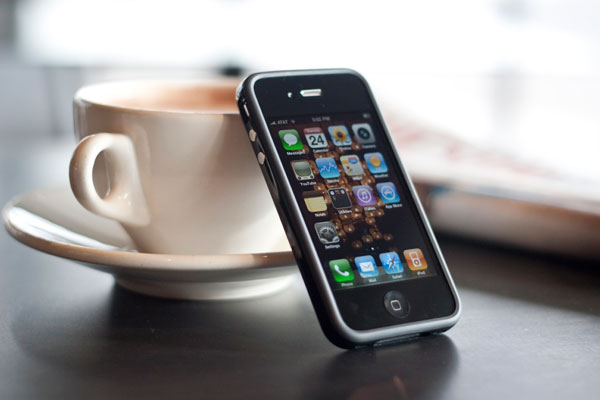
Apple's iPhone 4 with Bumper Case
It's a self fulfilling prophecy. Steve gets up on stage, proclaims the iPhone 4 to be the biggest introduction since the original iPhone, and the public flocks to Apple stores to fork over $200 on day one and around $2500 over the course of two years for the privilege. But this isn't 2007. Apple has real competitors in the smartphone space. Android phones have grown in features, polish and popularity. Even Palm entered the race with a competant offering, and Microsoft isn't far behind. It's easy to start a revolution when everyone else is doing the wrong thing, but what about when more companies actually get it? Was Steve justified in his excitement over the 4? That's what we're here to find out today.
Straight on it looks like just another iPhone. You get the black face with a shiny trim. From the side it is the redesign that Apple has needed for a while now. It’s not revolutionary but it’s the type of improvement that makes its predecessor feel old. And that’s exactly what this does. Have a look for yourself:
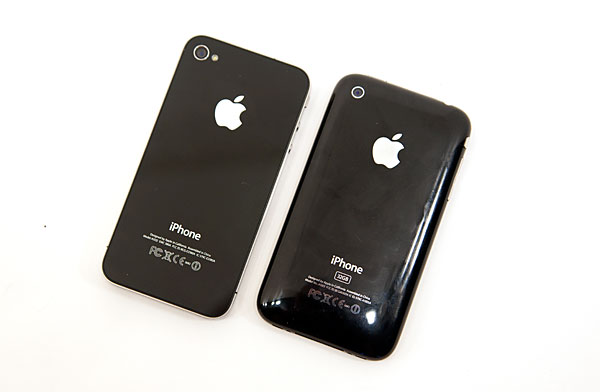
iPhone 4 (left) vs. iPhone 3GS (right)
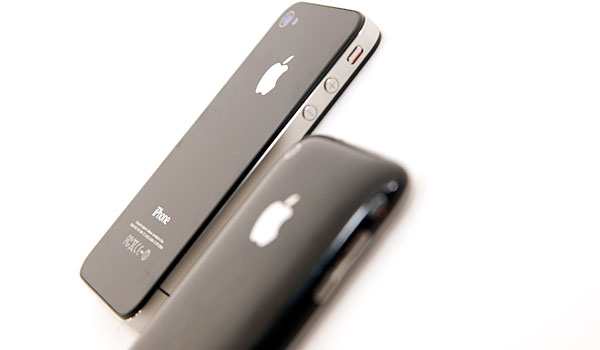
The straight lines, smaller dimensions and lack of unnecessary bulk make the 3GS feel like a car from the 90s, unnecessarily curvy. The styling is now so much more compact. Compared to the iPhone 3GS the 4 is around 5% narrower (but no more difficult to type on) and nearly 25% thinner. It even makes the Nexus One look dated:
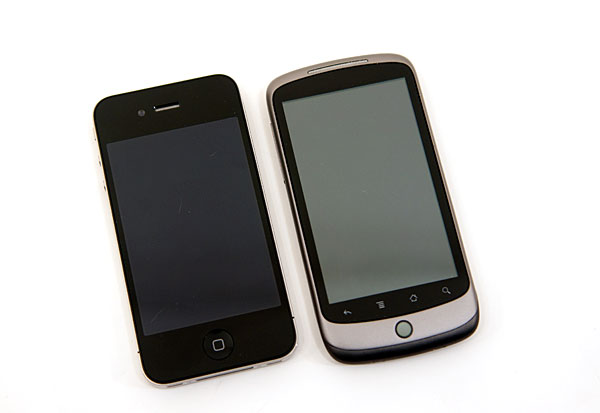
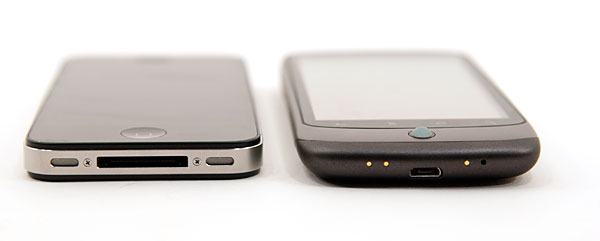
The iPhone 4 is slightly heavier than the 3GS (4.8oz vs. 4.7oz). You feel the added weight but I wouldn't call it heavy. The front and the back of the iPhone 4 are both made out of glass, and they protrude beyond the stainless steel band that wraps around the phone (more on this controversial decision later). While this gives the 4 an amazing finish, it also makes carrying the phone nerve racking. Coupled with the smaller, more dense form factor I’m now deathly afraid of dropping and shattering this thing. Apple has done a lot to reinforce the glass, however there have been enough reports already of shattered iPhone 4s for me not to feel very safe. Only Apple would think to make the two surfaces most likely to hit something out of glass. It's like making mouse traps out of cheese, something bad is bound to happen.
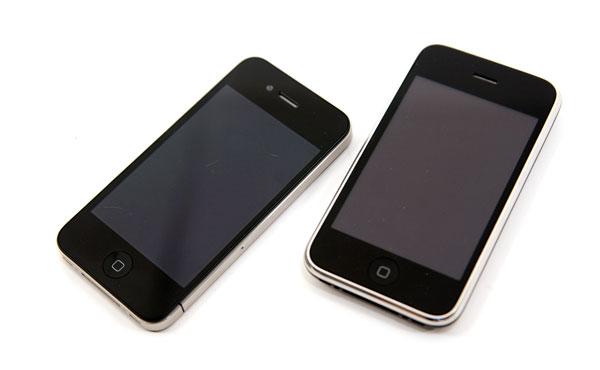
iPhone 4 (left) vs. iPhone 3GS (right)
The physical buttons (but not their layout) have changed on the 4. The ringer switch has shorter travel and feels sturdier as a result. The volume rocker has been replaced by discrete volume up/down buttons, also very sturdy in feel. The power/lock button is also now made out of stainless steel. Only the home button remains unchanged, although it does seem to make a deeper click when you use it.

The speaker moved to behind the right grill at the bottom of the phone instead of the left. The dock connector thankfully remained unchanged. It looks like Apple is committed to maintaining this connector until it makes the jump to something wireless (or optical?).

The back of the phone is pretty. Apple broke with tradition and finally included a single LED flash on the phone. The flash comes on in low light conditions and is enough to take shots in total darkness.
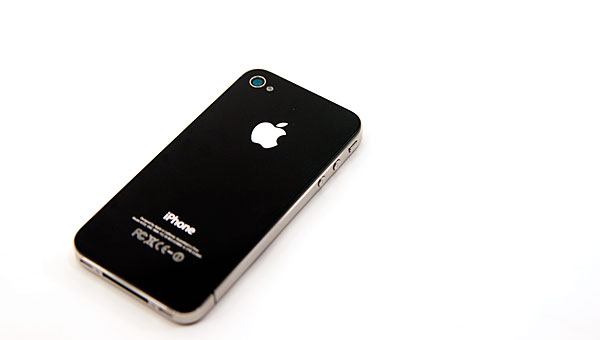
The camera has been upgraded to a low noise 5MP sensor. It can shoot stills at up to 2592 x 1936 or video at 1280 x 720 @ 30 fps. We’ll go into greater detail on its quality in the camera section. The iPhone 4 also adds a front facing camera capable of shooting both photos and video at 640 x 480.
Apple quotes contrast ratio as 1000:1, in our measurements we got very close (952:1). A significant improvement over the 188:1 ratio of the 3GS. Apple achieved this by both dropping black levels and increasing the white levels on the display. Improving both is always fine by me.
Internally the iPhone 4 uses Apple's new A4 SoC, built around an ARM Cortex A8 CPU and a PowerVR SGX GPU. The new SoC is built on a 45nm process and features 512MB of memory on the package. Apple hasn't made CPU clock speed public, but I'm guessing around 800MHz compared to the iPad's 1GHz for reasons you'll see later. GPU clock speed is unknown as well. Having more memory on package is an interesting move by Apple as it makes the iPhone 4 better suited for multitasking compared to the iPad. Also implying that shortly after the iPad gets multitasking it'll be updated to a version with more memory as well.
The iPhone now has an gyroscope as well the rotation sensors of its predecessors. Developers are given full access to the gyroscope making the iPhone 4 capable of becoming a very expensive Wii-mote.
| Physical Comparison | ||||||||
| Apple iPhone 4 | Apple iPhone 3GS | HTC EVO 4G (Qualcomm Snapdragon QSD8650) | HTC Droid Incredible (Qualcomm Snapdragon QSD8650) | Google Nexus One (Qualcomm Snapdragon QSD8250) | ||||
| Height | 115.2 mm (4.5") | 115 mm (4.5") | 121.9 mm (4.8") | 117.5 mm (4.63") | 119 mm (4.7") | |||
| Width | 58.6 mm (2.31") | 62.1 mm (2.44") | 66.0 mm (2.6") | 58.5 mm (2.30") | 59.8 mm (2.35") | |||
| Depth | 9.3 mm ( 0.37") | 12.3 mm (0.48") | 12.7 mm (0.5") | 11.9 mm (0.47") | 11.5 mm (0.45") | |||
| Weight | 137 g (4.8 oz) | 133 g (4.7 oz) | 170 g (6.0 oz) | 130 g (4.6 oz) | 130 g (4.6 oz) | |||
| CPU | Apple A4 @ ~800MHz | Apple/Samsung A3 @ 600MHz | Qualcomm Scorpion @ 1GHz | Qualcomm Scorpion @ 1GHz | Qualcomm Scorpion @ 1GHz | |||
| GPU | PowerVR SGX 535 | PowerVR SGX 535 | Adreno 200 | Adreno 200 | Adreno 200 | |||
| RAM | 512MB LPDDR1 (?) | 256MB LPDDR1 | 512MB LPDDR1 | 512MB LPDDR1 | 512MB LPDDR1 | |||
| NAND | 16GB or 32GB integrated | 16 or 32GB integrated | 8GB micro SD | 8GB micro SD | micro SD | |||
| Camera | 5MP with LED Flash + Front Facing Camera | 3MP | 8MP with dual LED Flash + Front Facing Camera | 8MP with LED Flash | 5MP with LED Flash | |||
| Screen | 3.5" 640 x 960 LED backlit LCD | 3.5" 320 x 480 | 4.3" 480 x 800 | 3.7" 480 x 800 AMOLED | 3.7" 480 x 800 AMOLED | |||
| Battery | Integrated 5.254Whr | Integrated 4.51Whr | Removable 5.5Whr | Removable 4.81 Whr | Removable 5.18 Whr | |||
The iPhone 4's logic board shrinks in size thanks to further component integration, making room for a much larger battery. The 5.25Whr battery in the iPhone 4 is a 16% increase from what was in the 3GS, and 95% of what HTC put in the EVO 4G. While raw performance improved, it's clear that Apple's focus this time around was battery life. Again, we'll dive into specifics later in the review.
Moving back outside Apple surrounded the phone with a stainless steel band. This band doubles as the 3G, WiFi and Bluetooth antennas. And if you hadn't noticed, it also moonlights as a giant elephant. Let's talk about it.










270 Comments
View All Comments
metalev - Saturday, July 3, 2010 - link
I ploted the signal-strength-to-bars mapping for both Android and the iPhone 4 on the same axes:http://www.metalev.org/2010/07/android-vs-iphone-4...
This shows that the iPhone 4 consistently reports a higher percentage signal strength (as defined by the fraction of bars lit) than Android GSM devices at the same signal strength.
R. Johnson - Saturday, July 3, 2010 - link
I don't understand how Apple (Iphone4) can say the antenna issue is a math problem when I can sit here with all full antenna bars and then hold the phone with my left hand and get only half a bar within 15 seconds. I don't know what to trust anymore when Apple decides to use different math and different bars in an upcoming update. I am afraid they may now use different bars to have it APPEAR there is better reception than there really is.R. Johnson
SunSamurai - Saturday, July 3, 2010 - link
You better hurry and put on the tinfoil hat too.Give me a break. The article already pointed out it was a simple error in how the bars were representing signal. The actual numerical signal is actually better. They basically did the opposite of what youre freak'n out about.
navderek - Saturday, July 3, 2010 - link
@SunSamuraiPlenty of reason to freak out. This is a very obvious design flaw that has been overlooked by Apple, and now denied by Apple. I am an RF Engineer and when I watched the Apple keynote presentation of the device I almost fell off my chair when he presented the antenna design...Then I thought, no it must have a light coat of something to shield the antenna....guess not.
Apple is making profit hand over fist and paying sweatshop workers pennies to put these things together...the least they could do is provide free bumpers. No they won't though because they will open the door to legal issues...who cares, they can afford the legal costs and it would save their face and allow them to continue unscathed...Now they just look like any other greedy company out there. They've really lost there magic IMO. It's discouraging that profits > honor. They are a real good company and this will really hurt them.
StormyParis - Saturday, July 3, 2010 - link
The article is very nice, but the conclusion lets us down and not gently by falling into the fanboi worldview. I'm neither an Apple nor Android nor Palm fanboi. I recently bought an HD2, and I'm definitely NOT an MS fanboi. I just wanted the biggest possible screen, and the HD2's is 40% bigger than the iPhone's... it's not about resolution, but size: I'm getting old.If the Dell Streak had been out in my country, I'd probably have gotten it instead. If palm had a big-screen, keyboardless phone, I'd have strongly considered it, seeing that right before the HD2, I was still using my Palm TX because it just works.
Right now I wouldn't consider Apple because it's too closed, and too cumbersome to get content onto (iTunes crapped out on my PC every time I tried it). I'm not sure I could get winhttrack'ed sites onto it.
I think most phones have reached the point of "good enough". On mine, I'm using a browser, an ebook reader, a media player... and that's about it. I don't game, I don't do social web things, I don't need a fashion accessory/personality crutch...
SunSamurai - Saturday, July 3, 2010 - link
You sound bitter. Tell us where the iphone/droid touched you.btharms - Saturday, July 3, 2010 - link
My phone drops from 5 bars to 1 bar frequently. The way I comfortably hold the phone covers the black strip more often than not. I have run speed test after speed test, and what I have found is that while covering the strip, my 3g connection will drop to 0kbps! I can literaaly freeze safari while loading any web page by temporarily placing my finger on the black strip (it will continue to load a second or two after I remove my finger).I was achieving download speeds of around 1600 kilobits/sec with the phone in my hand without covering the black strip. When redoing the test while holding the phone normally (with my pinky finger covering the strip) the speed dropped as low as 0 (100 kilobits per second was the fastest). Actually, many times the test would not start until I removed my pinky from the spot. Then, after the test began I would softly place my pinky back on the strip - and instantly the speed drops near 0.
So as thorough as your testing was, realizing that the phone misrepresents signal strength is really not a pertinent issue when you consider that the 3g signal virtually dissapears immediately on contact with the black strip.
I'm basically demanding that apple comps me a free bumper or i'm returning my phone.
navderek - Saturday, July 3, 2010 - link
The main point is that by Apple redoing the math on the signal bars...it will have no effect on the issues your seeing. Bars don't man a thing. Real life means everything and if the call drops with 5 bars or zero bars it does not matter - the call still drops!THIS IS JUST A STUNT BY APPLE TO PUT THE BLAME ON THE CARRIERS...OPEN YOUR EYES PEOPLE. Once the SW update happens then people will go back to complaining about AT&T and others...just like Apple wants it.
Thing is, poeple aren't as dumb as Apple thinks. But I guess this is the most financially obvious thing for Apple to do. Shift the blame, it's not our problem!
Mike Wadner - Saturday, July 3, 2010 - link
I started reading your review and stopped immediately upon seeing this statement: Apple has real competitors in the smartphone space. Android phones have grown in features, polish and popularity. Even Palm entered the race with a competant offering, and Microsoft isn't far behind.What cave have you been in for the last year? Do you not have a F**KING clue what Microsoft just did with their phone this week - THEY ARE MILES BEHIND EVERYONE IN HARDWARE AND SOFTWARE. My 13 year old kid wouldn't even make a statement this stupid.
Microsoft is stillborn when it comes to mobile. To even consider Microsoft a worthy competitor in the smart phone area is insane.
You're credibility just went down the crapper with that statement.
navderek - Saturday, July 3, 2010 - link
Agreed...the review may be good to the laymen, but for others not so much. I highly respect Anandtech's reviews but this is really the first one I've seen where they seem to have done the review just to get some of that Apple limelight without actually asking the tough questions like why Apple went and designed the antenna like this? What is the link between this poor antenna design and the sudden sale of bumpers by Apple? hmmmmmm